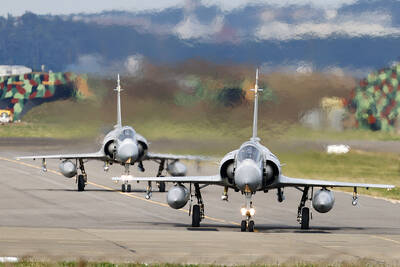Prosecutors in Chiayi yesterday charged two leaders of the Ho Ming-teh Charitable Group for allegedly misappropriating nearly NT$700 million (US$25.01 million) from donations over 18 years.
The organization was founded in memory of engineer Ho Ming-teh (何明德), who from 1965 led a volunteer movement to build bridges and pave roads in remote areas of Chiayi, Yunlin and Tainan counties.
Originally an informal collection of volunteers and donors, Ho later adopted the name Chiayi Philanthropy Group after the moniker was given to his initiative by Chinese-language newspapers.

Photo: Lin Yi-chang, Taipei Times
Ho in 1995 earned a Ramon Magsaysay Award in Community Leadership from the Philippines for “improving rural Taiwan with good deeds and sturdy bridges.”
The award panel praised Ho’s scrupulous bookkeeping, earning the group “a reputation for unshakable integrity.”
Ho’s eldest daughter, surnamed Chen (陳), in 2002 established the Ho Ming-teh Charitable Group with her husband, surnamed Hsiao (蕭), in memory of her father, the Chiayi District Prosecutors’ Office said.
Under the premise of continuing her father’s legacy, Chen and Hsiao solicited donations online, including through Facebook, for the unregistered organization, they said.
Prosecutors said that Chen and Hsiao garnered NT$1.42 billion in donations from 2002 to last year.
From 2002 to March, they had allegedly used NT$720 million on bridge construction and other philanthropic works, with NT$5.99 million left in an account, prosecutors said.
The remaining NT$695.71 million was allegedly used to purchase financial investments, high-value insurance and real estate, they said.
To conceal the source of the funds, they allegedly made the majority of the investments in their own names and those of their family members, contravening the Money Laundering Control Act (洗錢防制法) and embezzlement provisions of the Criminal Code, prosecutors said, adding that NT$693.06 million has been seized.
As Chen and Hsiao took advantage of donors’ goodwill and diverted funds meant for the public good to investments obviously contrary to their intended use, prosecutors recommended a heavy punishment to deter potential copycat offenders.
Chen and Hsiao denied the charges, saying that they kept the donations in private accounts as they did not register the organization and therefore could not open a dedicated account, prosecutors said.

Taiwan is gearing up to celebrate the New Year at events across the country, headlined by the annual countdown and Taipei 101 fireworks display at midnight. Many of the events are to be livesteamed online. See below for lineups and links: Taipei Taipei’s New Year’s Party 2026 is to begin at 7pm and run until 1am, with the theme “Sailing to the Future.” South Korean girl group KARA is headlining the concert at Taipei City Hall Plaza, with additional performances by Amber An (安心亞), Nick Chou (周湯豪), hip-hop trio Nine One One (玖壹壹), Bii (畢書盡), girl group Genblue (幻藍小熊) and more. The festivities are to

Auckland rang in 2026 with a downtown fireworks display launched from New Zealand’s tallest structure, Sky Tower, making it the first major city to greet the new year at a celebration dampened by rain, while crowds in Taipei braved the elements to watch Taipei 101’s display. South Pacific countries are the first to bid farewell to 2025. Clocks struck midnight in Auckland, with a population of 1.7 million, 18 hours before the famous ball was to drop in New York’s Times Square. The five-minute display involved 3,500 fireworks launched from the 240m Sky Tower. Smaller community events were canceled across New Zealand’s

‘IRRESPONSIBLE’: Beijing’s constant disruption of the ‘status quo’ in the Taiwan Strait has damaged peace, stability and security in the Indo-Pacific region, MOFA said The Presidential Office yesterday condemned China’s launch of another military drill around Taiwan, saying such actions are a “unilateral provocation” that destabilizes regional peace and stability. China should immediately stop the irresponsible and provocative actions, Presidential Office spokeswoman Karen Kuo (郭雅慧) said, after the Chinese People’s Liberation Army (PLA) yesterday announced the start of a new round of joint exercises around Taiwan by the army, navy and air force, which it said were approaching “from different directions.” Code-named “Justice Mission 2025,” the exercises would be conducted in the Taiwan Strait and in areas north, southwest, southeast and east of Taiwan

UNDER WAY: The contract for advanced sensor systems would be fulfilled in Florida, and is expected to be completed by June 2031, the Pentagon said Lockheed Martin has been given a contract involving foreign military sales to Taiwan to meet what Washington calls “an urgent operational need” of Taiwan’s air force, the Pentagon said on Wednesday. The contract has a ceiling value of US$328.5 million, with US$157.3 million in foreign military sales funds obligated at the time of award, the Pentagon said in a statement. “This contract provides for the procurement and delivery of 55 Infrared Search and Track Legion Enhanced Sensor Pods, processors, pod containers and processor containers required to meet the urgent operational need of the Taiwan air force,” it said. The contract’s work would be